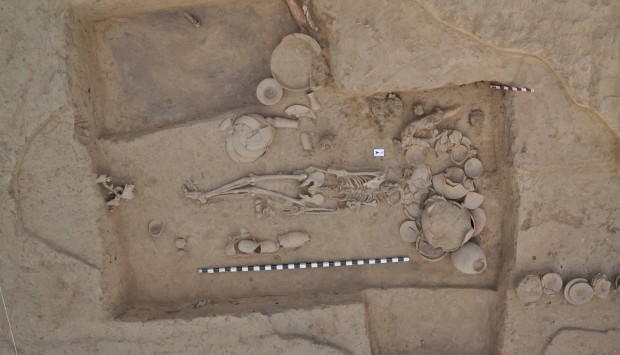
Skeleton of the Rakhigarhi woman, whose genome the scientists analysed. © Vasant Shinde/DCPGRI
The first genome sequence of a woman from Rakhigarhi, the largest town in Indus Valley Civilisation, has shed some light on the origins of people who built this ancient civilisation around five millennia ago1.
The DNA belongs to a woman who was buried four to five millennia ago in Rakhigarhi, now part of Haryana in India. Her genes point to an ancestry of ancient Iranians and Southeast Asian hunter-gatherers.
Genetic scientists say this does not mean that her ancestors lived in Iran or Southeast Asia. In fact, they almost certainly lived in South Asia for thousands of years before her.
The study also offers new insights into how farming began in South Asia. “Our findings do not prove a separate invention of farming in South Asia,” says geneticist David Reich from the US-based Harvard Medical School. Reich, who led a team of researchers from India, Germany and the US to sequence the genome, says their data is consistent with the theory that Western Asian agricultural technology or ideas moved into South Asia through adoption or ideas from neighbours.
Ancient human remains found in various sites of Indus Valley hardly yield intact DNA. The hot and humid conditions in these regions destroy any trace of DNA. To overcome this, Reich and post-doctoral scientist Vagheesh Narasimhan at Harvard, teamed up with Vasant Shinde from the Deccan College Post-Graduate and Research Institute in Pune and Niraj Rai from the Birbal Sahni Institute of Palaeosciences in Lucknow. They painstakingly screened 61 skeletal samples excavated from graves in Rakhigarhi and were eventually able to detect a very small amount of DNA in a single sample from a woman’s remains.
After more than hundred attempts, they were able to sequence the DNA. Comparing this DNA with those of 11 individuals from two sites in Turkmenistan and Iran, the researchers prepared a genetic profile of the Rakhigarhi woman.
The profile, they say, has signs of Iranian-related ancestry but no evidence of pastoralists who lived in the grasslands of Asia and Europe. “We say ‘Iranian-related’ because we don’t know where they lived,” Reich says. They could have lived in the Iranian plateau, but the team’s data point to them having lived in South Asia for many thousands of years before the Indus Valley Civilisation, he adds.
“This is a significant technical feat,” says Partha Pratim Majumder, an expert on human evolution and migration at the National Institute of Biomedical Genomics in West Bengal, India. “Sequencing genomes from South Asia has been a major challenge,” he adds.
This single sequence, he says, has provided a deep, though likely incomplete, insight into the Indus Valley lineage.
The analysis by Reich and colleagues also shows that the Iranian-related lineage present in the Indus Valley people split from the natives of Zagros Mountains in Iran before 8000 BCE. This is before crop farming began there around 7000–6000 BCE.
This suggests that the descendants of the world’s first farmers who lived in the Fertile Crescent have had no roles in introducing farming to South Asia.
Ancient DNA studies have shown that the hunter-gatherers in western Anatolia, a region in modern-day Turkey, adopted agriculture from their neighbours in the east. They then spread agriculture as they moved into Europe.
“Something similar might have happened in the vicinity of South Asia, where a hunter-gatherer population could have copied farming innovations from their eastern neighbors, and then spread them further through movement of people,” Reich points out.
There is little doubt that farming arose multiple times in different regions of the world, including in India, contends Majumder. Fossilized pollen grains, he says, point to multiple plant domestication and farming events in India. Thus, South Asia, in particular India, has always been a prominent seat of ancient farming, he adds.
The Indus Valley people built a complex and cosmopolitan culture, and variations are hard to decipher by decoding the genome of an individual, the researchers note. However, the insights that emerge from an individual genome demonstrate the promise of ancient DNA studies in South Asia, they add.
References
1. Shinde, V. et al. An ancient Harappan genome lacks ancestry from Steppe pastoralists or Iranian farmers. Cell. 179, 1-7 (2019) doi: 10.1016/j.cell.2019.08.048
